ABOVE NORMAL WEATHER AHEAD FOR AUGUST
MUSKOKA — This morning’s rain shouldn’t put a damper on the rest of the week, which looks good — through to Sunday night.
A wet start to August will see a rebound the next few days, with above average temperatures for the second month of the summer.
That’s not just an anecdotal observation from MuskokaTODAY.com’s first-person weather watch.
But the official word from Environment Canada.
It says in a July review release this week that going forward temperatures are forecast to continue to be above normal across the province this month, but probably not to the same degree as during the month of July.
They say there is little clear signal regarding precipitation, with the exception of a wet beginning the days ahead for Southern Ontario; and likewise a dry beginning in the Northwest.

It’s different story from a wetter than normal July, when Ontario experienced warmer than normal temperatures throughout the province with anomalies ranging between 1 and 4°C.
Moosonee Airport reached the highest mean temperature ever recorded in the area, shattering the previous record of 18.9°C held in 1959.
Toronto (25.4°C) and Kapuskasing Airport (20.2°C) also reported notably high mean temperatures.
Ontario was affected by three heat events: from the beginning of the month to the 10th, the 17th to the 19th and the 25th to the 27th. On July 9th, humidity made it feel like 42 in Toronto, 41 in Windsor, 43 in Sarnia, and 40 in Ottawa.
Most of the province received below-normal precipitation amounts; anomalies ranged from normal to half the expected amounts.
However, this is not representative of the precipitation patterns for some areas as parts of the north received well-above-normal precipitation amounts, with anomalies of +25 to +75%.
Despite the small monthly totals for most of the province, some intense rainfall events from thunderstorms and rain showers are worth mentioning below in the Significant Events section.

| Observations compared to the 1981-2010 normals for July 2020 (see Appendix for a geographic representation of all of Ontario) City | Mean Temp (obs/normal) (°C) | Difference
(°C) |
Total Precip (obs/normal)
(mm) |
| Kenora | 21.4 / 19.7 | 1.7 | 73.6 / 103.4 |
| Moosonee | 19.2 / 15.8 | 3.4 | 82.3* / 96.8 |
| OttawaAirport | 24.0 / 21.0 | 3.0 | 54.0 / 85.5 |
| Sudbury | 20.7 / 19.1 | 1.6 | 156.0 / 76.9 |
| Thunder Bay1 | 20.0 / 17.6 | 2.4 | 129.2 / 89.0 |
| Toronto Pearson | 25.0 / 21.5 | 3.5 | 67.6 / 71.5 |
| Windsor | 24.6 / 23.0 | 1.6 | 77.0 / 89.2 |
*Estimated or incomplete value; 1971-2000 normals used
Significant July events:
July 3: Violent Storm in Northern Ontario
A violent storm struck Weagamow Lake First Nation (also known as North Caribou Lake FN), 500 km north of Thunder Bay on Friday afternoon. There was damage to many roofs, small structures, and vehicles, and a large number of trees were knocked down.
July 4: Hailstorm in TemiskamingShores
A violent hailstorm struck Temiskaming Shores / New Liskeard late Saturday evening, damaging dozens of homes and vehicles.
July 8: Heavy Rain in Toronto
A severe thunderstorm struck the west end of Toronto Wednesday afternoon. Gusty winds estimated to be in excess of 90 km/h uprooted large trees in multiple places, including High Park and the neighborhood of York. There was extensive street flooding in multiple locales as well, including High Park, Queensway, Black Creek Blvd and Lakeshore Blvd. Sixty-five (65) mm of rainfall was recorded in 30 minutes by the Toronto and Region Conservation Authority (TRCA) station at Westmount Park. A flood warning was issued by the TRCA, and Black Creek broke its banks in several places. At the height of the storm, Toronto Hydro reported 45,000 customers were without power.
July 10-11: Rain in the South; Thunderstorm in Hawkesbury
Thunderstorms affected most of southern and central Ontario beginning Friday afternoon and into the early hours of Saturday. The main impact was heavy rain which caused local flooding. There was a report of 62 mm in 55 minutes in Waterdown near Hamilton.
looding also occurred on the westbound QEW just west of Dixie Avenue. While most of the precipitation tapered off during the evening hours, some areas along the north shore of Lake Erie continued to receive rainfall into Saturday afternoon. Road washouts were reported in areas near Dutton; fields were flooded in Norfolk County.
Rainfall amounts well exceeded the 50 mm in 24 hours mark in multiple regions across southern Ontario, with even a couple of Community Collaborative Rain, Hail & Snow Network (CoCoRAHS) reports close to 150 mm.
There were also locally strong winds resulting in downed trees, and a report of a landspout tornado in Milton on the Friday.
Meanwhile over eastern Ontario, a brief, but intense thunderstorm caused significant damage in the town of Hawkesbury late on Friday afternoon.
Trees were toppled, a few cars crushed, power lines downed – all in the space of a few minutes near 5 p.m.
Later that night and into the early hours of July 11, the remnants of Tropical Storm Fay, which came ashore in New Jersey and then tracked northward towards southern Quebec, provided up to 25 mm of rain to eastern Ontario, especially along the St. Lawrence River, but nowhere near the amounts that had been expected.
July 19: Squall Line across Southern Ontario with Multiple Tornadoes
A line of thunderstorms originating in Minnesota roared across Michigan and Lake Huron overnight and crossed southwestern Ontario beginning mid-morning on Sunday.
By late morning, a squall line had clearly developed and showed signs of rotation on radar, prompting tornado warnings for multiple regions between London, Listowel, Halton, and Peel.
Numerous damage reports were received from this squall line, and subsequent investigations by the Northern Tornadoes Project (NTP) of Western University concluded that there had been six tornadoes, in addition to a number of downbursts. Fortunately, most of the damage was to trees and farm buildings, with the exception of the Belmont tornado, where some house roof damage was observed.
July 29: Locally Heavy Rain Southeast of Ottawa
A line of thunderstorms provided a good soaking for a narrow band of mostly rural land southeast of Ottawa Wednesday evening. Radar indicated accumulations of 50 to 100 mm from Barrhaven to Casselman and east towards Montreal. Those numbers were confirmed by volunteer reports in the area including a notable one from St. Isidore with 106 mm.

